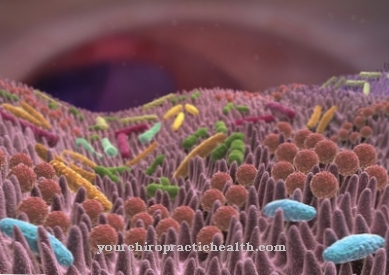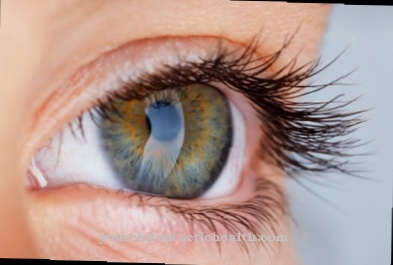The Insulin production takes place in the islets of Langerhans in the pancreas. A lack of or no insulin production leads to type 1 diabetes mellitus.
What is Insulin Production?

Insulin is a vital hormone that works with glucagon to regulate blood sugar levels. It is produced in the ß-cells (beta cells) of the pancreas. The ß-cells are only found in the islets of Langerhans. Derived from the Latin word insula, the Langerhans Islands gave the hormone its name. The job of insulin is to regulate the blood sugar level. To do this, it smuggles glucose from the blood into the body's cells.
In the case of insufficient or no insulin production, type 1 diabetes mellitus occurs. It is an autoimmune disease. While there is an absolute insulin deficiency in type 1 diabetes mellitus, there is a relative insulin deficiency in type 2 diabetes mellitus. There is a lot of insulin in the blood, but due to the insulin resistance of the cells, this is not enough to transport the glucose into the cells. In the long run, however, type 2 diabetes mellitus can also result in a lack of insulin.
Insulin synthesis takes place in the Langerhans Islands. In a first step, the messenger RNA is translated into preproinsulin on the ribosomes. It is a protein that consists of 110 amino acids. In the next step, the molecule is folded. This creates two chains that are linked by disulfide bridges.
The signal peptide is necessary for this connection. It is split off after the connection is established. Another cleavage of the C-peptide creates the actual insulin molecule after it has passed through the Golgi apparatus. The insulin molecule then consists of two peptide chains. After production, the individual insulin molecules are stored in the vesicles of the Golgi apparatus. These are located directly on the cell membrane of the insulin-producing ß-cells.
Function & task
The stimulus for the release of the insulin molecules is a blood sugar level from 5 mmol glucose per liter of blood. Various amino acids and free fatty acids can also cause a release and stimulation of production. Secretion is also stimulated by the hormones secretin, GLP-1, GIP and gastrin. In particular, the glucose-dependent insulinotropic peptide (GIP) plays an important role. It stimulates insulin production and insulin secretion after eating.
The insulin is released in spurts. Insulin molecules are released into the blood every three to five minutes. A biphasic course can be seen. The first major insulin release occurs three to five minutes after eating. This first peak lasts around ten minutes. Most of the insulin molecules come from the memory. The second phase lasts as long as there is hyperglycaemia in the blood. This phase is mainly determined by newly formed insulin. The insulin-producing cells are very active during this second phase after eating and produce abundant insulin.
In the blood, insulin ensures that the glucose reaches the target cells from the blood. To do this, the hormone binds to special insulin receptors and enables the glucose molecules to enter the target cells. Muscle and liver cells have a particularly large number of insulin receptors. You can therefore absorb large amounts of glucose within a very short time and store it in the form of glycogen or convert it into energy.
Illnesses & ailments
In type 1 diabetes mellitus, the cells of the immune system turn against the ß-cells of the islets of Langerhans. Type 1 diabetes mellitus is therefore one of the autoimmune diseases. Why these autoimmune processes occur is still unclear. Genetic predisposition seems to play a crucial role.
The autoimmune processes in the pancreas are usually insidious and go unnoticed for a long time. Only when 80 percent of the ß-cells are destroyed is the insulin production no longer sufficient to lower the blood sugar level.
The first symptoms appear within a few days or weeks. Type 1 diabetes mellitus is characterized by increased thirst and the need to urinate. Those affected are tired and exhausted due to the lack of energy. You suffer from dry skin and a flaky scalp.
An acetone-like odor in the air you breathe is an indication of ketoacidosis and thus also a sign of a metabolic disorder. When the cells no longer receive enough glucose to produce energy, they generate energy from fats. This creates ketone bodies. In large quantities, these lead to acidification of the body. So-called metabolic acidosis develops. Characteristic for this acidification is a fruity smell of the breath and the Kussmaul breathing.
In diabetes mellitus, the ß-cells of the pancreas initially work normally. They produce enough insulin, but the cells are insulin resistant. So that the glucose gets from the blood into the cells, ever larger amounts of insulin are necessary. Despite the increased insulin levels in the blood, hyperglycaemia occurs. So here is not an absolute insulin deficiency, as in type 1 diabetes mellitus, but a relative insulin deficiency. If this condition persists, a vicious circle develops. The ß-cells produce more and more insulin and at the same time the body cells become more and more insensitive to the hormone. This increases the production of insulin again. Ultimately, the cells of the pancreas can become exhausted, so that insulin production is completely or partially stopped. Then, similar to type 1 diabetes mellitus, there is an absolute insulin deficiency.



























